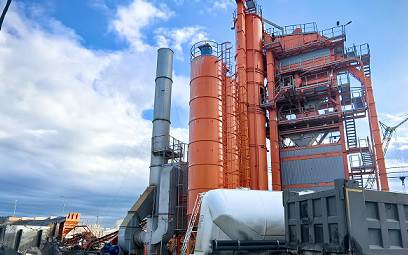Land selection for environmentally friendly asphalt mixing plant construction
1: The site should be located on higher ground and away from residential areas and densely populated areas.
Because part of the equipment of the mixing station is installed below the ground, in order to avoid continuous rainfall. The equipment will suffer disaster, and the changing aggregate moisture content will affect the concrete quality. Quality accidents are prone to occur. Therefore, during site construction, attention should be paid to the construction of drainage pipelines and sand and gravel quarries. With the rapid development of cities. As the city continues to expand, environmental protection requirements will become more and more stringent. Gravel vehicles are prohibited from traveling on urban roads, so concrete mixing plants should be built far away from the urban area.


2: The venue should consider the transportation distance and choose a location with convenient transportation
During the transportation of concrete, it must be ensured that concrete segregation and other ferry losses are controlled within the specification. Consider shipping time constraints for commercial concrete. Zhengzhou New Water Engineering believes that the economic operation radius of commercial concrete should generally be controlled at 15-20km. Moreover, the mixing station needs to transport a large amount of raw materials and commercial concrete, and convenient transportation is conducive to reducing transportation costs.
Three: Determine the website construction plan according to the terrain
Concrete asphalt plants should be built in areas with relatively uneven terrain. Generally, the upper layer is a sand and gravel aggregate field, and the lower layer is the mixing station host and underground reservoir. In this way, the registered aggregates can be easily unloaded into the asphalt batching plant through the loader, and it is very convenient to collect rainwater. A reasonable layout based on the terrain can lay a solid foundation for future production.
 Albanian
Albanian  Russian
Russian  Arabic
Arabic  Amharic
Amharic  Azerbaijani
Azerbaijani  Irish
Irish  Estonian
Estonian  Odia (Oriya)
Odia (Oriya)  Basque
Basque  Belarusian
Belarusian  Bulgarian
Bulgarian  Icelandic
Icelandic  Polish
Polish  Bosnian
Bosnian  Persian
Persian  Afrikaans
Afrikaans  Tatar
Tatar  Danish
Danish  German
German  French
French  Filipino
Filipino  Finnish
Finnish  Frisian
Frisian  Khmer
Khmer  Georgian
Georgian  Gujarati
Gujarati  Kazakh
Kazakh  Haitian Creole
Haitian Creole  Korean
Korean  Hausa
Hausa  Dutch
Dutch  Kyrgyz
Kyrgyz  Galician
Galician  Catalan
Catalan  Czech
Czech  Kannada
Kannada  Corsican
Corsican  Croatian
Croatian  Kurdish (Kurmanji)
Kurdish (Kurmanji)  Latin
Latin  Latvian
Latvian  Lao
Lao  Lithuanian
Lithuanian  Luxembourgish
Luxembourgish  Kinyarwanda
Kinyarwanda  Romanian
Romanian  Malagasy
Malagasy  Maltese
Maltese  Marathi
Marathi  Malayalam
Malayalam  Malay
Malay  Macedonian
Macedonian  Maori
Maori  Mongolian
Mongolian  Bengali
Bengali  Myanmar (Burmese)
Myanmar (Burmese)  Hmong
Hmong  Xhosa
Xhosa  Zulu
Zulu  Nepali
Nepali  Norwegian
Norwegian  Punjabi
Punjabi  Portuguese
Portuguese  Pashto
Pashto  Chichewa
Chichewa  Japanese
Japanese  Swedish
Swedish  Samoan
Samoan  Serbian
Serbian  Sesotho
Sesotho  Sinhala
Sinhala  Esperanto
Esperanto  Slovak
Slovak  Slovenian
Slovenian  Swahili
Swahili  Scots Gaelic
Scots Gaelic  Cebuano
Cebuano  Somali
Somali  Tajik
Tajik  Telugu
Telugu  Tamil
Tamil  Thai
Thai  Turkish
Turkish  Turkmen
Turkmen  Welsh
Welsh  Uyghur
Uyghur  Urdu
Urdu  Ukrainian
Ukrainian  Uzbek
Uzbek  Spanish
Spanish  Hebrew
Hebrew  Greek
Greek  Hawaiian
Hawaiian  Sindhi
Sindhi  Hungarian
Hungarian  Shona
Shona  Armenian
Armenian  Igbo
Igbo  Italian
Italian  Yiddish
Yiddish  Hindi
Hindi  Sundanese
Sundanese  Indonesian
Indonesian  Javanese
Javanese  Yoruba
Yoruba  Vietnamese
Vietnamese  Hebrew
Hebrew  Chinese (Simplified)
Chinese (Simplified)






.jpg)
